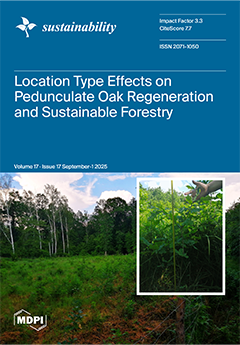Hard coal mining activity generates post-mining waste (waste rock). Waste rock is deposited in the environment in large quantities for reclamation of agricultural land. In this study, waste rock was treated as a potential source of metal pollutants. The research material (waste rock,
[...] Read more.
Hard coal mining activity generates post-mining waste (waste rock). Waste rock is deposited in the environment in large quantities for reclamation of agricultural land. In this study, waste rock was treated as a potential source of metal pollutants. The research material (waste rock, soil, plant roots, and Lumbricidae earthworms) was obtained from sites that had been reclaimed using waste rock as well as sites without waste rock. From each site, 30 individuals (n = 30) were collected, divided into five groups, 6 individuals each. Within the group, individuals were analyzed collectively. The study tested whether selected metals (Cr, Ni, Cd, Ba, Pb, Zn, and Cu) are present in waste rock and whether they can be transferred to the soil, plant root systems, and representatives of Lumbricidae, which are important bioindicators and a source of biomarkers. Particular attention was focused on the assessment of the effects of metals deposited
in situ on fatty acids in representatives of Lumbricidae and on selecting a set of fatty acids that can be used as biomarkers of physiological effects, including oxidative stress. A panel of biomarker fatty acids was used, which included a panel of 17 biomarker fatty acids from 35 fatty acids analyzed. To confirm or disprove the usefulness of the biomarker fatty acid panel in earthworms, superoxide dismutase (SOD), catalase (CAT), and thiobarbituric acid reactive substances (TBARS) were determined. The study enabled an effective comparison of reference locations with locations potentially burdened with anthropogenic sediment. The results indicate that selected metals present in the waste rock are transferred to the soil, plant root systems, and soil organisms such as Lumbricidae. Selected metals affected the lipid metabolism of Lumbricidae as stressors, leading to changes in the composition and oxidation of fatty acids. The effect on the physiological state of Lumbricidae depended on the duration of the deposit and the type of use (field, meadow, wasteland) of the land with the waste rock deposit. In earthworms obtained from sites with waste rock deposits, higher contents of biomarker saturated fatty acids and biomarker monounsaturated fatty acids and lower contents of biomarker polyunsaturated fatty acids were found compared to earthworms obtained from sites without waste rock deposits. Only Pb (lead) showed a statistically significant correlation with all analyzed parameters in earthworms obtained from sites with waste rock deposits. The results have significant practical implications for environmental protection management. The proposed set of biomarker fatty acids in Lumbricidae can be used to assess the impact of pollutants and environmental monitoring.
Full article





